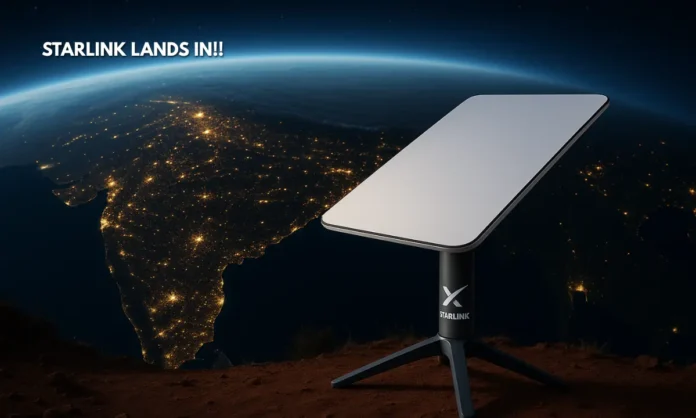Summary
- Starlink will begin services in India within two months, offering satellite internet via a ₹33,000 device and a ₹3,000 monthly plan.
- The company, licensed by the Department of Telecommunications, joins OneWeb and Reliance Jio as India’s satellite internet providers.
- Starlink aims to bridge digital gaps in remote Indian regions, leveraging its global low-Earth orbit satellite network.
Satellite Signal, Local Stakes: Starlink’s Rural India Debut
India’s long-fragmented digital landscape is bracing for a new player: Starlink. Elon Musk’s satellite internet venture, known for its aggressive global expansion, is now officially licensed by India’s Department of Telecommunications (DoT). The company is expected to begin services within the next two months and, if successful, could transform broadband access in regions long ignored by traditional networks. While the pricing — ₹33,000 for the hardware and ₹3,000 per month for unlimited data — may not appeal to urban price-conscious consumers, its true play lies elsewhere: the underserved and offline.
The launch marks India as the 101st market for Starlink, positioning it as a disruptor in both consumer access and policy dynamics. India’s broadband gaps aren’t merely infrastructural—they’re political, cultural, and economic. Starlink’s bet hinges on a critical equation: high upfront cost, but higher potential for regional impact.
Elon Musk’s Starlink to Launch in India Within 2 Months! 🇮🇳🚀
— ELON UNFILTERED (@Elonology_) June 10, 2025
Starlink is officially set to roll out high-speed internet services across India after securing license approval.
➠ Launch in 2 months
➠ 1-month FREE trial
➠ Device cost: ₹33,000
➠ Monthly plan: ₹3,000… pic.twitter.com/HZAwWgR9Hv
Who’s Online and Who’s Left Behind?
- Starlink will serve India’s remote areas where fiber and mobile data networks remain limited or unreliable.
- India has over 700 million internet users, but rural access remains patchy, with more than 300 million people still offline.
- Traditional telecoms have struggled with last-mile connectivity, especially in geographically challenging regions.
- Starlink’s low-Earth orbit satellites promise latency and speed comparable to fiber, but accessibility depends on affordability.
Starlink’s stated agenda in India is straightforward: serve the underserved. Its low-Earth orbit (LEO) satellite constellation promises low-latency, high-speed internet to regions where cellular towers and fiber cables are unfeasible. From the tribal belts of Odisha to the flood-prone deltas of Assam, this could mean connecting millions who’ve never had reliable broadband.
Yet that promise comes at a premium. At ₹33,000 for the dish and ₹3,000 monthly thereafter, Starlink’s target is clearly not the average farmer or daily wage worker—unless backed by subsidies or state partnerships. For comparison, rural mobile data plans in India start at ₹149 a month. Starlink will need to build its case on quality, not cost.
Musk’s India Strategy: Private Deals, Public Push
- Starlink signed infrastructure pacts with Reliance Jio and Bharti Airtel earlier this year to aid deployment.
- Starlink’s model mimics its rollouts in Bangladesh and Bhutan, where it offered similar device and data pricing.
- The government has hinted at enabling private telecom–satellite collaborations to meet Digital India goals.
- Industry sources say Starlink’s rollout may coincide with pilot programs in remote government-run schools and clinics.
Elon Musk is not operating in a vacuum. Starlink’s India entry comes after quiet negotiations with India’s two largest telecom giants: Reliance Jio and Bharti Airtel. These partnerships could be crucial to managing distribution, device servicing, and even regulatory goodwill. With OneWeb (partly owned by Bharti) already running test deployments, the competition for remote spectrum dominance is heating up.
Musk has also learned from his 2021 stumble, when Starlink prematurely started taking Indian preorders without a license—prompting a swift government crackdown. This time, the strategy is cleaner and more coordinated, aided by policy shifts that now encourage private players to contribute to national digital infrastructure goals.
Global Signals, Local Noise: Can Starlink Win Rural India?
- Starlink enters India amid rising geopolitical concerns over control of digital infrastructure by foreign companies.
- Critics argue that without local data storage and strong policy oversight, satellite internet may compromise national security.
- Proponents see it as a leapfrog opportunity for villages stuck in 2G zones or with no internet access at all.
- The model’s long-term viability may depend on subsidy partnerships with state or central governments.
Starlink’s arrival also opens up familiar questions about data sovereignty, surveillance, and control. While internet freedom activists see potential for digital empowerment, skeptics in India’s policy circles remain wary. With data localisation rules tightening, Starlink must ensure that it plays by India’s evolving digital sovereignty rules if it wants to scale.
Then comes the public-private puzzle. A model reliant on ₹33,000 devices may falter unless the government subsidizes access for critical sectors like education, health, and agriculture. State-run schools, primary health centres, or panchayat offices in shadow zones may be Starlink’s best foot forward—offering visibility, impact, and future user bases.
Final Verdict: Between the Stars and the Soil
Starlink’s India strategy is both bold and brittle. The ambition to connect the disconnected is noble, and Elon Musk’s brand power may unlock doors faster than traditional players. But the economics of rural India are unforgiving. Price-sensitive, politically sensitive, and infrastructure-deficient, India’s underserved regions need more than a flashy satellite dish. They need trust, local servicing, and affordability—all while avoiding policy landmines.
If Starlink manages to blend aspiration with accessibility, it won’t just be a luxury internet provider for remote schools or startup hubs in Ladakh. It could become a backbone of Digital India 2.0. But only if the stars align—and stay grounded in India’s messy digital soil.


